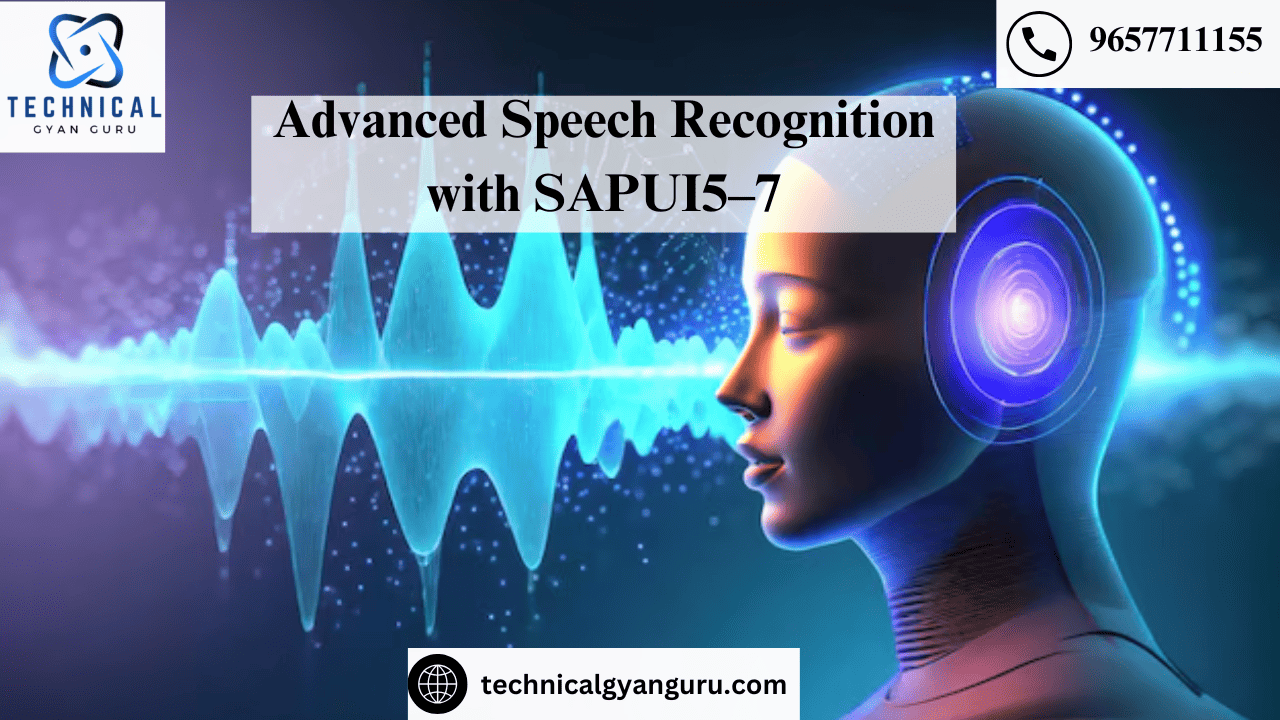
Introduction
Speech recognition technology has advanced quickly in recent years, making it possible for people to engage with digital systems in more efficient and natural ways. Integrating cutting-edge speech recognition into SAPUI5, a powerful framework for creating enterprise-grade web applications, presents a number of chances to enhance user experience, expedite processes, and allow accessibility features. With an emphasis on integrating voice commands for a more seamless and effective user experience, this article will examine how to integrate sophisticated speech recognition with SAPUI5.
What is SAPUI5?
- A JavaScript-based framework called SAPUI5 enables programmers to design user interfaces (UIs) for SAP applications. To assist developers in creating responsive, cutting-edge, and effective online apps, it provides a vast array of controls and functionalities. The main purpose of SAPUI5 is to create user interfaces for SAP cloud apps, such as SAP Fiori apps, which have established themselves as the industry standard for SAP UI design.
- Because of SAPUI5’s scalability and versatility, developers may construct highly configurable apps while yet keeping an intuitive user experience. It makes sense to incorporate sophisticated speech recognition into SAPUI5 apps in order to improve the user experience and future-proof them in light of the increasing demand for more approachable and intuitive interfaces.
The Importance of Speech Recognition in Modern Applications
- Speech Recognition’s Significance in Contemporary Applications
The applications of voice recognition technology have advanced significantly since its inception. These days, it is employed in many other sectors, including as healthcare, retail, banking, and the automobile industry, to mention a few. The main advantage of adding speech recognition to apps is that it enables more natural, hands-free user interaction. - This implies that in the context of SAPUI5, users could do operations like data search, screen navigation, and even form data submission by only speaking. This has important ramifications, especially for sectors like manufacturing, shipping, and healthcare where hands-free operations are crucial.
- Moreover, voice interactions are key to improving accessibility for users with disabilities or those in environments where typing or clicking is difficult. Integrating advanced speech recognition into SAPUI5 applications can open up new levels of usability, inclusivity, and efficiency.
Benefits of Integrating Speech Recognition in SAPUI5

- Hands-Free Interaction: Users can interact with apps using speech recognition instead of a mouse or keyboard. This is especially helpful in settings like warehouses or operating rooms where users could be preoccupied with other duties.
- Increased Efficiency: Because spoken commands are quicker than typing, users can complete tasks like data searches, form filling, and complex menu navigation more rapidly.
- Enhanced User Experience: Voice-based interactions give apps a more natural and intuitive feel, which can increase user engagement and happiness.
- Accessibility: By eliminating the need for conventional input devices, speech recognition can let users with visual impairments or mobility issues connect with apps.
- Real-Time Data Entry: Users can dictate information into the system, eliminating the need for manual data entry. This can significantly reduce errors and improve accuracy in data-driven applications.
Implementing Advanced Speech Recognition in SAPUI5
It’s not as hard as it would seem to incorporate speech recognition into SAPUI5 applications. Developers may effortlessly include voice interactions into SAPUI5 applications with the use of contemporary web APIs such as the Web Speech API, which encompasses both speech recognition and speech synthesis. Implementing Advanced Speech Recognition in SAPUI5.
Step 1: Set Up Speech Recognition API
- The Web Speech API offers a speech recognition interface for recognizing speech input in web applications. This API supports languages and provides options for continuous recognition and partial transcription.
To begin using the Speech Recognition API in your SAPUI5 application, you will first need to ensure that your browser supports it. Currently, browsers like Google Chrome and Edge support the Web Speech API.
Here’s how you can set up the basic speech recognition functionality in SAPUI5:
javascriptCopy code// Initialize the speech recognition object
const recognition = new window.SpeechRecognition() || new window.webkitSpeechRecognition();
// Set the language for speech recognition
recognition.lang = 'en-US';
// Enable continuous recognition
recognition.continuous = true;
// Start the recognition process
recognition.start();
// Listen for the result event when speech is detected
recognition.onresult = function(event) {
const transcript = event.results[event.resultIndex][0].transcript;
console.log("Speech recognized: ", transcript);
// Further action like updating a model or triggering other UI actions
};
Step 2: Integrate Speech Recognition with SAPUI5 Controls
- Now that you have set up basic speech recognition functionality, you can integrate it with SAPUI5 controls such as buttons, forms, or search fields to enable voice commands for specific actions.
For example, imagine you want to add voice command functionality to a search field. When the user speaks a search query, the app will automatically execute the search based on the recognized text.
javascriptCopy code// Get reference to the search field control
var oSearchField = this.getView().byId("searchField");
// Update search field with the recognized text
recognition.onresult = function(event) {
const transcript = event.results[event.resultIndex][0].transcript;
oSearchField.setValue(transcript);
// Optionally trigger a search function
oSearchField.fireSearch();
};
This integration allows users to simply speak their search queries, improving the app’s usability.
Step 3: Handling Special Commands and Actions
- For more advanced use cases, you can handle specific voice commands, such as “Go to Home”, “Submit form”, or “Navigate to Dashboard”. This requires setting up a command mapping mechanism that associates recognized speech with specific actions in your app.
javascriptCopy code// Define command-action mappings
const commands = {
"Go to Home": () => { window.location.href = "/home"; },
"Submit form": () => { this._submitForm(); },
"Open dashboard": () => { this.getRouter().navTo("dashboard"); }
};
// Listen for recognized speech and trigger associated actions
recognition.onresult = function(event) {
const transcript = event.results[event.resultIndex][0].transcript;
if (commands[transcript]) {
commands[transcript]();
}
};
This approach allows users to perform complex operations with simple voice commands, reducing the number of UI interactions needed.
Step 4: Enhancing Accuracy and Performance
- For more accurate and reliable speech recognition, you can fine-tune settings or integrate third-party APIs like Google Cloud Speech-to-Text, Microsoft Azure Speech, or IBM Watson. These services offer enhanced speech recognition capabilities, especially in noisy environments, with support for multiple languages and accents.
To use a third-party service, you would need to set up an API key and make requests to their API endpoints, passing the audio data for transcription. Here’s a basic example using the Google Cloud Speech API:
javascriptCopy code// Make API call to Google Cloud Speech-to-Text
const response = await fetch('https://speech.googleapis.com/v1p1beta1/speech:recognize', {
method: 'POST',
headers: { 'Authorization': `Bearer ${API_KEY}`, 'Content-Type': 'application/json' },
body: JSON.stringify({
config: {
encoding: 'LINEAR16',
sampleRateHertz: 16000,
languageCode: 'en-US'
},
audio: { content: audioData }
})
});
const data = await response.json();
console.log("Recognized text: ", data.results[0].alternatives[0].transcript);
By integrating such services, you can dramatically improve the accuracy of speech recognition in noisy or complex environments.
Conclusion
- Advanced speech recognition can be included into SAPUI5 apps to increase user pleasure, accessibility, and engagement. Developers can produce cutting-edge voice-enabled apps that meet a variety of user needs, from hands-free operation to increased data entry accuracy, by utilizing contemporary online APIs and cloud services. The future of enterprise application user experience will surely be shaped by the combination of SAPUI5’s adaptability and speech recognition capabilities.
- As you experiment with speech capabilities in your SAPUI5 apps, keep in mind the unique requirements of your users, do thorough testing in various settings, and make sure the integration improves rather than detracts from the user experience. The possibilities for developing extremely engaging and effective SAP apps are endless as voice recognition technology advances.
you may be interested in this blog here
Salesforce Roadmap to Success: Mapping Out Your Training Journey
Empowering Your ABAP ALV with Integrated Data Access (IDA) on HANA:…







